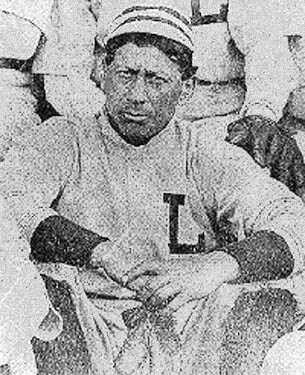This is an old revision of this page, as edited by Studerby (talk | contribs) at 23:07, 1 July 2007 (fix cat sorting). The present address (URL) is a permanent link to this revision, which may differ significantly from the current revision.
Revision as of 23:07, 1 July 2007 by Studerby (talk | contribs) (fix cat sorting)(diff) ← Previous revision | Latest revision (diff) | Newer revision → (diff)
Louis Sockalexis (b. October 24, 1871 on Indian Island Old Town, Maine; d. December 24, 1913, in Burlington, Maine) was a was a Penobscot and the first Native American Major League Baseball player. His career with the National League team, the Cleveland Spiders, lasted three years.
Sockalexis became a rising baseball star in Maine in his teens. He attended the College of the Holy Cross and excelled in baseball, football, and track. In the 1894 season, Sockalexis posted a .436 batting average and posted .444 in 1895. Handsome and popular, Sockalexis was the school's star athlete. His games attracted large crowds and "Sock," as he was called, was the most sought-after college ballplayer in the country.
Louis Sockalexis transferred to the University of Notre Dame in December, 1896 but in early March 1897, was expelled for drinking and destroying a local brothel after the madam refused to provide her services to a "red man."
On March 9, 1897, Sockalexis signed a major league contract with the Cleveland Spiders. In his first three months, he posted a .338 batting average. Sockalexis generated great enthusiasm among Cleveland sportswriters and fans with his spectacular plays in right field, speedy base-stealing and powerful hitting at the plate. Sockalexis hit only three major league home runs but each one was dramatic in the deadball era.
Fifty years before Jackie Robinson faced derision and abuse as the first African American in the majors, Sockalexis endured hostile crowds and racial taunting as the first Native American. In Cleveland as well as other cities, crowds and opposing ballplayers jeered and showered him with abuse, but as Robinson did in his rookie year with the 1947 Brooklyn Dodgers, Sockalexis displayed restraint and dignity and soon won favor with his exciting plays on the field.
From his college days, Sockalexis had developed a drinking habit that worsened in Cleveland. By July 1897, his heavy drinking led to a literal fall from stardom when he suffered a leg injury after jumping from the second story of a brothel. After the injury, he never regained his speed in the field and saw only limited playing time in 1898 and 1899. In 1899 he was released from the team.
After leaving Cleveland, Sockalexis signed with various minor leagues in Connecticut. He finished the 1899 season under the careful management of former batting star Roger Conner. Without the pressures of national fame and racist abuse, Sockalexis excited the smaller crowds with a display of his former skills in clutch hitting and game-winning home runs. Unfortunately, Sockalexis's alcoholism had become so severe that he drifted as a vagrant for three years and was arrested several times.
In 1902, Sockalexis signed with the Lowell Tigers (see photo) and "spiked himself to the water cart" as the saying went. He played a complete season and posted a .288 batting average. By 1906, he had gone back to Indian Island and regained sobriety. He ran a ferry across the Penobscot River in the summer months and worked as a logger in the winter.
In his last years, Sockalexis was able to share his talent with the people of Maine. He organized and coached a team of Penobscot youths, five of whom went on to the New England League. Crowds came to watch him umpire games for the Maine Leagues, and he was widely respected for his accurate calls and extensive knowledge of the rules. His friends recalled him for his quiet dignity, generosity and humor.
Sockalexis developed numerous health problems and died prematurely of heart failure at age 42 while working in a logging camp.
In 1963, baseball writer Lee Allen named James Madison Toy, an early American Association catcher as the first Native American in the majors. However, in January, 2006, Sockalexis biographer Ed Rice obtained Toy's death certificate which listed Toy's ethnicity as Caucasian, supporting the claim that Louis Sockalexis was indeed the first Native American Major League ballplayer.
Recently there has been controversy over the name of the Cleveland Indians and their mascot, Chief Wahoo. Although the "Indians" nickname dates back to Sockalexis' rookie season with the Spiders in 1897, the official name for the current American League team was selected by Cleveland sportswriters, not from a fan contest as numerous sources claim in 1915. Sockalexis had died two years earlier but there was no mention of him in the announcements. Newspaper cartoons of that era, as well as the team's current Chief Wahoo mascot, were and continue to be racially offensive to some and bear no resemblance to Louis Sockalexis.
Sources:
1. "Baseball's First Indian: Louis Sockalexis, Penobscot Legend, Cleveland Indian" by Ed Rice (Tidemark Press, 2003)
2. "Louis Sockalexis: The First Cleveland Indian" by David Fleitz (McFarland & Company, 2002]] 3. "Sockalexis: Maine's Great Ballplayer," article by Francis Hatch in "Downeast Magazine," 1963
External links
- Baseball Reference Profile
- Louis Sockalexis page on Find A Grave site